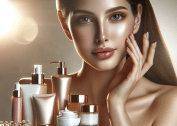Curious about facial serums and the skin transformations people talk about? Explore how nutrient-packed concentrates target concerns like aging, dullness, and dryness. This guide walks through serum science, realistic effects, and what to know before you try these trending beauty staples.
Understanding Facial Serums and Their Appeal
Facial serums are everywhere in wellness and beauty conversations, often surrounded by bold claims and confusing ingredient lists. But what truly makes a serum different from other types of skincare? At their core, serums are lightweight skincare products formulated with higher concentrations of active ingredients. Unlike traditional creams or lotions, a facial serum delivers targeted nutrients such as vitamin C, hyaluronic acid, or antioxidants directly to your skin. This design makes them a staple for those seeking radiant, hydrated, or rejuvenated complexions. Their popularity continues to rise as more people want solutions for fine lines, discoloration, and overall skin health — sometimes with less product and minimal routines.
Part of their appeal is how serums can be tailored to specific needs. One person might look for a serum with retinol to smooth out uneven texture; another might prefer options packed with niacinamide to help minimize visible pores or regulate oil. Serums typically absorb quickly, making them ideal layering tools alongside moisturizers and sunscreen. Unlike heavier skincare products, their thin consistency ensures actives penetrate more deeply. Some dermatologists recommend introducing a serum when changes in the skin are first noticed, such as loss of elasticity or new spots, for a well-rounded wellness approach (Source: https://www.aad.org/public/everyday-care/skin-care-basics/care/skincare-product-safety).
The conversation on facial serums isn’t just about what’s hottest or trending. There’s a genuine curiosity about how effective these concentrated formulas are and whether investing in one delivers real, visible results. Online searches reflect a demand for transparency regarding what ingredients do and how to combine them safely. In this guide, you’ll learn how facial serums work with your skin barrier and what to look for to get the most value from your beauty regimen. People love experimenting with different blends, but understanding the science behind each bottle makes all the difference.
Key Ingredients That Power Facial Serums
The huge variety of facial serums is driven by diverse ingredients that target unique skin goals. Vitamin C is a frequent star, prized for its reputation in brightening dull skin and chasing away visible sun spots. Many serums also feature hyaluronic acid, a humectant that draws and retains moisture, often leaving skin plumper and smoother. Retinol and its plant-derived cousins support the skin’s renewal cycle, making them essential picks for visible aging concerns. These actives are carefully balanced to maximize benefit while minimizing irritation, especially for sensitive skin types.
Some people turn to peptides, amino acid complexes that help reinforce the skin barrier against environmental stressors. Others find comfort in serums boasting niacinamide or squalane — milder, hydrating molecules that calm redness or soften dryness. With antioxidant-rich options like ferulic acid or green tea extract, buyers get a defense boost against day-to-day damage from pollution. Dermatologists often emphasize reading ingredient lists carefully to avoid layering products that could interact negatively. If you’re inclined to use multiple serums, it helps to consult with a skin professional or review trusted online resources from organizations like the Skin Cancer Foundation (https://www.skincancer.org/blog/skin-care-ingredients/).
Transparency in beauty is increasingly important. People want to know if an ingredient not only sounds impressive but is supported with real research. Many brands and websites now make it easier to lookup the function — and the science — behind each extract or compound. Serums shaped by careful formulation and clinical trials tend to attract loyal followings, especially among wellness seekers who value evidence-based approaches. Always verify sources and avoid jumping blindly into trends. The right facial serum can serve as a confidence booster when selected for your unique needs and with clear, unbiased information behind every vial.
How Serums Fit Into a Holistic Skin Routine
Building a holistic skin care routine means understanding how each product complements and supports others. Serums play a key transitional role. Their lightweight, fast-absorbing textures are perfect for applying immediately after cleansing but before moisturizing. This stepwise approach helps with ingredient penetration. If you use actives like vitamin C, those go underneath sunscreen during the day, reinforcing skin defenses against sun and pollution. At night, some people switch to serums with retinoids or AHA/BHA acids, which work best on freshly cleaned skin and before applying nourishing creams or oils.
Routine-building isn’t about using more products. It’s about knowing how to get the most out of each one. Some users find their skin needs change with the seasons or over time. In winter, a serum with hyaluronic acid may ward off dryness; in humid months, niacinamide or lightweight botanicals can keep oiliness at bay. Rotating serums or using them only on targeted areas allows for a personalized approach that respects individual concerns. Industry groups like the American Academy of Dermatology offer guidance to help avoid layering products that can trigger irritation (https://www.aad.org/public/diseases/a-z/skin-care-myths).
Mindful use of serums encourages a deeper connection with wellness rituals. Applying a few drops with gentle tapping motions isn’t just science — it’s self-care. A routine can transform from a rushed obligation to a moment of relaxation and reflection. Many report noticeable improvements in skin texture and tone when following routines tailored to their needs and schedules. Balance is the goal. With the right steps, serums become powerful allies that fit seamlessly into anyone’s pursuit of healthy, radiant skin.
What Results Can You Expect From Serums?
Expectations about serum results vary widely. Some rave about visibly brighter, firmer, or smoother skin in weeks. Others report subtler improvements such as increased hydration and overall radiance. The most reliable outcomes stem from consistent use and realistic timeframes. Studies suggest that active ingredients like retinol or vitamin C may require four to twelve weeks to show measurable difference in fine lines or spots (Source: https://www.ncbi.nlm.nih.gov/pmc/articles/PMC6017965/). Serums aren’t miracle workers overnight. Instead, they provide steady benefits with patience and proper layering.
Daily stress, sun exposure, and other lifestyle factors can impact visible effects. Using serums alongside sunscreen, healthy sleep, and a balanced diet maximizes positive outcomes. Some notice redness or tingling with new actives — usually a sign to slow down and give skin a chance to adjust. Consulting dermatology sources ensures you recognize the difference between mild adaptation and genuine sensitivity issues. Websites like Harvard Health Publishing break down the science, helping people separate hype from possible results (https://www.health.harvard.edu/staying-healthy/the-science-of-serums).
Measuring serum success goes beyond mere appearance. Improved confidence, softer skin, and an enjoyable skincare process count as meaningful results for many. Product reviews, before-and-after photos, and advice from professionals all add layers of insight. In the end, success often stems from aligning product claims with trusted studies and honest feedback, not just advertising. Facial serums support ongoing skin wellness — not a singular transformation, but incremental, sustainable change.
How to Choose a Serum for Your Skin Type
Serum selection can feel overwhelming. With so many choices, matching product to skin type matters most. Dry complexions often crave hydrating ingredients like hyaluronic acid, which pulls water into the skin for instant plumping. Oily or acne-prone users might prefer serums with niacinamide or salicylic acid to balance oil and target clogged pores. Those with sensitive skin are usually advised to start slow with gentler extracts, and avoid strong actives at first. Ingredient transparency, fragrance-free options, and dermatologist-tested claims may reduce the risk of unwanted reactions (Source: https://www.mayoclinic.org/healthy-lifestyle/adult-health/in-depth/skin-care/art-20048237).
If you don’t know your skin type, try tracking how your face feels by midday — shiny, tight, flaky, or comfortable. A consultation with a board-certified dermatologist or an evidence-based online quiz can help clarify the most suitable starting points. Keep sun protection in the mix, since active serums can sometimes increase sun sensitivity. Checking reviews and science-backed testimonials may narrow your options further, but always patch-test new items before full use. Trusted sources, like the Cleveland Clinic’s advice on facial products, give a solid foundation for first-time buyers (https://health.clevelandclinic.org/face-serum-what-are-the-benefits).
The most rewarding serum is one you look forward to using. That means a pleasant texture, manageable scent, and authentic improvement over time. Some people keep more than one serum in rotation, switching based on how their skin feels or looks. Tracking your progress (and setbacks) helps you refine choices with confidence. Brands that publish detailed research or partner with dermatology clinics are increasingly favored by those who value facts over fads. In the world of facial serums, personalization is the path to lasting beauty and real results.
Exploring Clinical Insights and Safety Practices
Science-driven wellness trends have pushed facial serums into the spotlight of clinical studies. Researchers examine how active ingredients influence collagen formation, skin barrier resilience, and visible markers like pigmentation or wrinkles. Many published trials demonstrate the effectiveness of compounds such as vitamin C and retinoids when applied in prescribed amounts over extended periods. This research has made it easier to select serums not on hype, but on measured outcomes. Still, product safety remains a cornerstone of responsible use, regardless of the trend’s popularity.
It’s important to keep skin safety at the forefront of any new regimen. Dermatologists recommend patch-testing every new serum — applying a small amount to a clean patch of skin and waiting 24–48 hours for redness or irritation. Many people skip this step! Reviewing authoritative safety tips from groups like the U.S. Food & Drug Administration (FDA) can prevent common mistakes (https://www.fda.gov/consumers/consumer-updates/skin-care-products-whats-new-aging). Safety also means watching for ingredient incompatibilities, such as mixing potent acids and retinoids in the same routine, and always checking expiration dates.
Beauty is evolving. Today, clinical data and global research drive trends, not marketing alone. Independent review organizations, dermatology societies, and consumer groups evaluate claims for accuracy and risk. With more consumers investigating what’s inside every drop, transparency is setting a new standard. When exploring facial serums, trusted science and safe practices lead the way to healthy, glowing skin — and a new appreciation for self-care.
References
1. American Academy of Dermatology. (n.d.). Skin care product safety. Retrieved from https://www.aad.org/public/everyday-care/skin-care-basics/care/skincare-product-safety
2. Skin Cancer Foundation. (n.d.). Popular skin care ingredients. Retrieved from https://www.skincancer.org/blog/skin-care-ingredients/
3. American Academy of Dermatology. (n.d.). Skin care myths. Retrieved from https://www.aad.org/public/diseases/a-z/skin-care-myths
4. Mukherjee, S. et al. (2016). Retinoids in the treatment of skin aging: An overview of clinical efficacy and safety. Retrieved from https://www.ncbi.nlm.nih.gov/pmc/articles/PMC6017965/
5. Harvard Health Publishing. (n.d.). The science of serums. Retrieved from https://www.health.harvard.edu/staying-healthy/the-science-of-serums
6. Mayo Clinic. (n.d.). Skin care: 5 tips for healthy skin. Retrieved from https://www.mayoclinic.org/healthy-lifestyle/adult-health/in-depth/skin-care/art-20048237









